ATTACK ON THE WORLD TRADE CENTER ON SEPTEMBER 11, 2001
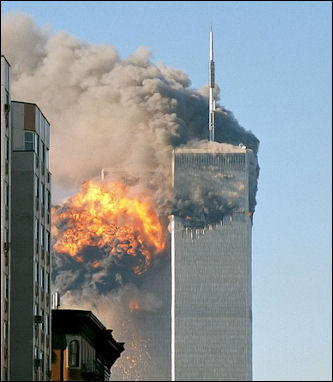
On September 11, 2001, two Boeing jets hijacked by terrorists with links to Al-Qaida were intentionally flown into the World Trade Center in New York. Both towers of the World Trade Center collapsed, killing 2,749 people. Another plan hits the Pentagon, killing 180. A forth plane, apparently headed for Washington, possibly the White House, crashed in Pennsylvania, killing 44. Altogether 2,973 people were killed, including dozens of Muslims.
The planes were hijacked by men with box cutters — presumably used to cut the throats of pilots and people who resisted them — and boxes they said had bombs. The purposely picked planes with few passengers so there would be few resisters on the planes and coordinated the attacks so they occurred at the same time while the planes were in air so no one could stop them.
The attackers had hoped to seriously damage the Twin Towers. In some accounts of the attack, the terrorists did not plan to cause the towers to collapse. The impact of the planes severed 66 of the 235 support columns within the buildings (42 on the 95th floor of the North Tower and 24 in the 80th floor of the South Tower) and the heat of the fires produced by the crashes melted many of the other support columns. This caused the floors above the crash to begin collapsing and the weight of the material plus the weakening of the supports caused both buildings to entirely collapse.
The cost to Al-Qaida for the September 11th attack is thought to have been just $400,000 to $500,000 spent over two years. Property damages and losses in New York were estimated at $40 billion or more. The total cost of the attack on the world economy was, by some reckonings, estimated to be $30 trillion. The United States and world economy slumped and by some estimated went into a recession. The airline and travel industries have still nor completely recovered.
Book: “The 9/11 Commission Report: The Attack from Planning to Aftermath” (2004) is a government-authorized report that according to the Washington Post “reads like a nonfiction thriller” and was a finalist for the National Book Award.
September 11 Hijackers
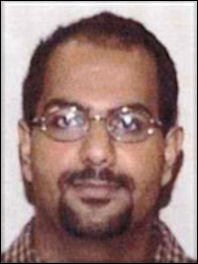
Marwan al-Shehhi,
9-11 hijacker There were 19 hijackers on four planes: 15 were Saudis, one was Tunisian, two were Egyptian, and one was from the United Arab Emirates. The four hijackers that flew the planes had attended flight schools in the United States.
Most of the hijackers were thugs whose duty was to slit the throats of the pilots and control the passengers. Some believe that many of the hijackers had no idea the planes were going to be flow into the World Trade Center. Osama bin Laden said he was “amused by the fact that some of these people who were martyred thought they just taking part in a hijacking.”
The hijackers were well funded. They received money to pay for flight school, apartments, automobile rentals and living expenses. The money is believed to have been supplied from Al-Qaida. Fifteen of the hijackers got visas at the U.S. Embassy in Saudi Arabia. The visas were quickly given with no interviews. Visas in Saudi Arabia are generally obtained through travel agencies and only around three percent are turned down.
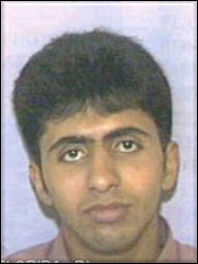
Mohand al-Shehri,
9-11 hijacker In the Arab and Muslim world it is widely believed that the Jews and the Mossad — not Al-Qaida — were behind the September 11th attacks. Some regard the hijackers as heros. Some Saudis say that the attack was the work of the Mossad, or at the very least the Mossad knew about the attack and could have stopped it. Other are proud of “the Fifteen” — the 15 Saudi hijackers. One man from Abha in the Asir, where four of the hijackers came from, told Time: “The Fifteen were protecting Islam. Most of the guys here want to become heroes protecting Islam.” It is cruelly ironic that most of the September 11th hijackers came from Saudi Arabia and Egypt, two countries whose rulers have traditionally been friendly with the United States.
Zacarias Moussaoui, a French citizen of Moroccan descent, initially was the only person charged in the United States in connection with the September 11 attacks. He drew attention at his flight school because he showed little interest in learning how to take off or land. In the end he was characterized as an Al-Qaida wannabe who was listed as a back up pilot but was not considered reliable enough to actually go through with the mission. He was given a life sentence rather than the death penalty, the jury decided, in part because he had a troubled childhood. After his sentence was read he shouted “America, you lost...I won.”
Mohammed Atta

Mohammed Atta Mohammed Atta, an Egyptian architecture student, was the leader of the hijackers and a man who piloted one of the planes into the World trade Center. He was recruited for Al-Qaida in Hamburg, Germany, where he was a university student, went through training in Afghanistan and learned to fly at a flight school in Florida, where he hung at local bars and rented Hollywood videos. His family in Egypt had a beach house on the Mediterranean; his father was a prominent lawyer in Cairo; two of his sisters were university professors with PhDs.
Atta’s parents were shocked that their son was one of the hijackers. His father said Mohammed was nervous about flying. His sister, who is a doctor, reportedly gave him medicine to control cramps and vomiting associated with his fear of flying. At first Atta’s father claimed it was impossible for his son to be involved in the September 11th attack. He claimed that Mossad agents kidnaped his son, stole his passport and carried out the attack. Four years after the attack Mohammed’s father told a CNN interviewer that he was proud that his son has started a 50-year-long religious war by setting up cells that were like a “nuclear bomb that has now been activated and is ticking.”
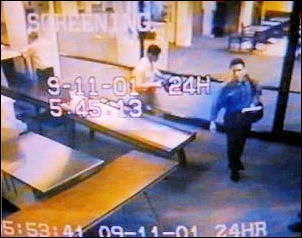
Mohammed Atta in the airport Mohammed Atta grew up in a middle class neighborhood in Cairo. His family described him as bright and studious and a person who avoided problems rather than creating them and was nervous around women. He studied at the Technical University in Hamburg, where his wrote his master’s thesis on restoring the classic Syria city of Aleppo. He was given a B+ . In Hamburg he hooked up with a prayer group, where he made connections with members of Al-Qaida. In 1997, he attended an Al-Qaida training camp in Afghanistan. Later he entered the United States with a student visa and attended flight school in Florida with some of the other hijackers. People that came in contact with him described him as arrogant and belligerent.
The day of the hijacking Atta flew on a commuter plane from Portland, Maine to Boston where he boarded the flight he presumably flew into one of the World Trade Center Towers. He nearly missed the Portland flight. In his instructions to his fellow hijackers Atta wrote, “You should feel complete tranquility, because the time between you and your marriage in heaven is very short.”
Khalid Sheik Mohammed Hatches the Plan for the September 11th Attack
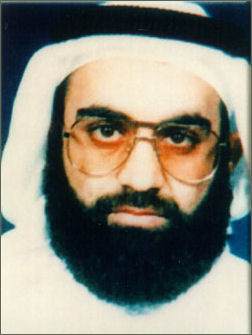
Khalid Sheik Mohammed in 2001 Khalid Sheik Mohammed said, “I was responsible for the 9/11 operation, from A to Z.” Peter Finn wrote in the Washington Post: “In 1996, when he described his plot for a direct attack on the United States using aircraft as weapons, bin Laden listened but did not immediately commit, according to the 9/11 Commission Report. In late 1998, after al-Qaeda succeeded in bombing the U.S. embassies in Kenya and Tanzania, bin Laden finally approved what the group came to refer to as the "planes operation." Under Mohammed's original plan for Sept. 11, 10 aircraft were to be hijacked. He was to have been aboard the only one not to crash, and after killing the male passengers he was to deliver a speech condemning U.S. support for Israel, as well as the Philippines and governments in the Arab world. The 9/11 Commission Report notes: "This vision gives a better glimpse of his true ambitions. This is theater, a spectacle of destruction with KSM as the self-cast star -- the superterrorist." [Source: Peter Finn, Washington Post, November 14, 2009]
Terry McDermott wrote in The New Yorker: “Mohammed’s initial proposal was to hijack a single airplane and crash it, as Abdul Murad had suggested, into C.I.A. headquarters. Bin Laden dismissed this target as inconsequential. So Mohammed proposed hijacking ten airliners in the United States, some on each coast. The plotters would crash nine of them, and Mohammed would triumphantly land the tenth, disembark, and give a speech explaining what he had done and why. Bin Laden thought that the plan was too complicated. It was not until late 1999 that he approved a somewhat less ambitious proposal: the 9/11 plan. [Source: Terry McDermott, The New Yorker, September 13, 2010]
“The idea was distinguished largely by its simplicity. It required pilots, and teams of men able to overwhelm defenseless air crews. It required money and the ability to move it around the globe. And it required willing suicide bombers — of whom, Mohammed has said, there was a surplus. By far the biggest difficulty was finding volunteers who could legally enter the United States. In two years, Mohammed was able to insert just nineteen men into the plot.
“During the planning of the attacks, Mohammed spent most of his time in Pakistan, and continued to organize plots and local terror cells around the world. He recruited people he had known from the Afghan training camps to form small organizations in their areas. U.S. investigators had no hint of Mohammed’s deepening involvement with Al Qaeda. They wanted him for his association with the Manila plot; that was enough to land him on the F.B.I.’s Most Wanted list, with a two-million-dollar reward. They tracked him, as they tracked bin Laden, but never put the two together.
See Separate Articles KHALID SHEIK MOHAMMED — MASTERMIND OF 9/11 — HIS LIFE, CAPTURE AND TRIAL factsanddetails.com KHALID SHEIK MOHAMMED: 9/11, TERRORIST PLOTS AND RAMZI YOUSEF factsanddetails.com
Khalid Sheik Mohammed Prepares the September 11th Attack
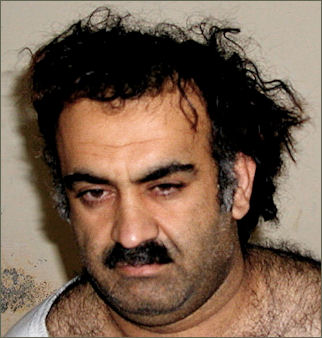
Khalid Sheik Mohammed at his arrest Terry McDermott wrote in The New Yorker: “Mohammed was a hands-off manager; he spent most of his time trying to recruit suitable volunteers and, once he had done so, gave them instructions and expected them to perform. He delegated the details of the plot — which flights, what day, the makeup of the hit teams — to Atta, who communicated his decisions to Mohammed through bin al-Shibh, mainly using coded e-mail exchanges and Internet chat rooms. While the pilots were being trained, Mohammed continued searching for men to join them in the United States. Most of those he found were Saudis who, like the pilots, had gone to Afghanistan to volunteer, and carried passports that allowed them easy access to the U.S. [Source: Terry McDermott, The New Yorker, September 13, 2010]
“Mohammed told investigators that bin Laden urged him several times to hurry up the attacks. He refused, waiting until the summer of 2001, when Atta told him the attack teams were set; in the meantime, he insulated the hijackers from bin Laden’s impatience. He also allowed Atta to overrule bin Laden’s choice of the White House as one of the targets — Atta thought it was too difficult — and substituted the Capitol.”
“Mohammed said that several dozen recruits and associates stayed at his Karachi apartment. One man was there for a two-week training course that ended just before September 11th. Recruits have described the instruction they received as basic — how to use the Yellow Pages, Internet chat rooms, and travel agencies. Mohammed taught them a code to use in their e-mails in which each digit in a telephone number was converted so that the original digit and the coded one added up to ten; for example, Mohammed’s Karachi cell-phone number, 92 300 922 388, became 18 700 188 722. He gave them simple word codes: a “wedding” was an explosion, “market” was Malaysia, “souk” was Singapore, “terminal” stood for Indonesia, and “hotel” for the Philippines. Thus, “planning a wedding at the hotel” would be planting a bomb in Manila. He received notes at various e-mail accounts, including silver_crack@yahoo.com and gold_crack@yahoo.com. (His password was “hotmail.”) Mohammed refused to respond to e-mail that didn’t follow the proper codes.
“In the summer of 2001, word began to leak out of Afghanistan that Mohammed”or Mukhtar, the “chosen one,” as he was known within Al Qaeda — was planning something big. ...Al Qaeda had called its most important operatives back to Afghanistan, to protect them. In late August, Mohammed travelled to Afghanistan to inform bin Laden personally of the date of the attacks, then returned to Pakistan. ...As the former C.I.A. director George Tenet put it, according to the 9/11 Commission Report, “The system was blinking red.” But, up until the moment of the hijackings, nothing illegal had occurred. That morning, nineteen young Arab men boarded four commercial airliners in much the same way tens of thousands of other men, women, and children did.
September 11 Hijackers Cell
Cells in Europe were responsible for setting up the September 11th attack. Mohammed Atta and two of the hijacker pilots were members of a cell that was set up in Hamburg, where Atta lived off on for eight years. The cell was run by a 300-pound Syrian named Mohammed Heider Zammar. In June 2001, he was arrested in Morocco and deported to Syria, where he was interrogated without worries about human rights violations.
According to some captured Al-Qaida members the September 11th attack was originally planned to be the first of three major attacks. The second and third attacks were supposed to involve an attack with biological agents or a radioactive dirty bomb followed up by attacks on natural gas and nuclear infrastructure.

Atta with a student group in Hamburg in 1993
Terry McDermott wrote in The New Yorker: “The two principals — Mohamed Atta, the lead pilot, and Ramzi bin al-Shibh, Atta’s roommate in Hamburg — came to Mohammed almost by accident. Neither had any known previous inclination toward terrorism. They were devout young men who had gone to Afghanistan as a first step in volunteering their efforts to the cause. They and two other Arab students from Hamburg happened to arrive in Afghanistan at precisely the time Al Qaeda needed men who could train to become pilots. [Source: Terry McDermott, The New Yorker, September 13, 2010]
“Atta was a finicky, dour man whose chief attributes were obedience and a capacity for detail. He held a part-time job as a draftsman for an urban-planning firm in Hamburg, where he reproduced city plans so precisely that his boss described him as “a drawing slave.” Bin al-Shibh was an affable layabout who rarely held a job for more than a few weeks and found university study not worth his effort. A man who knew them both in Hamburg said later that he would happily have testified against Atta in a trial but never against bin al-Shibh. “Omar,” he said, using bin al-Shibh’s nickname, “was cool.” Atta went to the United States in June, 2000. Bin al-Shibh remained in Germany, because he could not get a U.S. visa; the American immigration system viewed him as a likely economic migrant.”
Preparations for Attack on the World Trade Center
.png)
How the planes entered the
World Trade Center The September 11th plan was reportedly hatched in 1996 during at meeting in Tora Bora, Afghanistan between Khalid Sheik Mohammed, who had the original idea, and Osama bin Laden, who had access to the money and organization to actually carry it out. The original plan called for hijacking five jets on each coast. Mohammed was involved in the 1993 plan to destroy he World Trade Center and a plan hatched in the Philippines to bomb a dozen U.S. planes simultaneously.
In 1998, on the heels of the successful bombing of the U.S. embassies in Africa, bin Laden summoned Mohammed to Kandahar with hopes of pulling off something more ambitious. The September 11th plan was modified and given the okay at a meeting in early 1999 in Kandahar between Mohammed and bin Laden. According to Muhammad Atef who was at the meeting, Mohammed was told that his plan “now had Al-Qaida’s full support” and they already found four potential suicide bombers “so eager to participate in attacks against the United States that two of them already possessed U.S. visas.” These two — Nawal Alhanzo, and Khalid Almihdar — began training in the fall of 1999 and entered the United States in January 2000. Khalid checked aviation magazines, researched flight schools in the United States, bought video of hijacking movies, arranged travel, financing and communication for the hijackers and said he would have carried out the attack even without support from Al-Qaida and Osama bin Laden.
On January 5, 2000 planners of the attack on the World Trade Center in New York met in Malaysia. The meeting was attended by Al-Qaida military planners and two September 11th hijackers who flew to Los Angeles after the meeting and then enrolled in flight schools in San Diego.
Mohammed Atta and three others from Germany were recruited at the Afghanistan camps to head the operation. Atta was selected the leader and given the name emir. Osama bin Laden had a hand in picking the pilots and the 14 “muscle hijackers.” Originally the teams was supposed to be made up of men from many nations. It was bin Laden who chose mostly Saudis. The hijackers came to the United States with the intent of attending flight schools, learning how to fly passenger planes and selecting targets and then striking those targets. Saudis were chosen in part because it was easier for them to get visas than men from other countries.
Osama bin Laden and September 11th
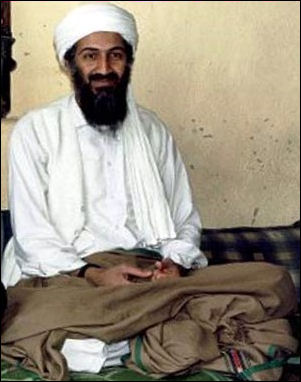
According the British government Osama bin Laden spoke about “a major attack on America” in the days before the attack on the World Trade Center in New York on September 11, 2001. According to an NBC report, he contacted his mother and told her to expect “big news.”
In the video in which bin Laden discussed the September 11th attack at an abandoned residence in the eastern Afghan city of Jalalabad, Osama bin Laden is shown sitting with a sheik from Saudi Arabia laughing and grinning about the destruction caused by the attack. In the video bin Laden said, “I was thinking that fire from the gas in the plane would melt the iron structure of the building and collapse the area where the plane hit and all the floor above it only...This was all we had hoped for.”
Osama bin Laden was reportedly very much of a hands-on leader in the planning of the September 11th attack. For example, when one of senior Al-Qaida planers of the attack insisted the one of the hijacker be replaced because he was ignoring his training, Osama bin Laden overruled him and insisted the hijacker in question participate. He also rejected proposals to expand the attacks to the West Coast of the United States and Asia and gave the final approval despite last minute cold feet by some senior Al-Qaida members. Bin Laden had originally wanted to hit the White House when Israeli Prime Minister Ariel Sharon was visiting thee in the spring of 2001.
Khalid Sheik Mohammed's Reaction to the Attack on the World Trade Center
Terry McDermott wrote in the The New Yorker: “According to a memoir by the former Pakistani President Pervez Musharraf, Mohammed watched news reports of the attacks at an Internet café in Karachi. When the first plane hit the first target, the World Trade Center, a celebration commenced. Bin al-Shibh, who, according to Musharraf, was with Mohammed, told Yosri Fouda that men in their company shouted “God is great!” and wept with joy. [Source: Terry McDermott, The New Yorker, September 13, 2010]
Peter Finn wrote in the Washington Post: “When two planes struck the twin towers of the World Trade Center in Manhattan on Sept. 11, 2001, Khalid Sheik Mohammed was sitting in an Internet cafe in Karachi, Pakistan, monitoring the attacks. At first, Mohammed later told CIA interrogators, he was disappointed. He said that he expected the towers to crumble immediately and that he feared they might not fall at all. [Source: Peter Finn, Washington Post, November 14, 2009]
“After the towers came down, Mohammed returned to a hideaway flat in the city. There, according to newly disclosed details from U.S. officials, he and a number of associates, including Ramzi Binalshibh, al-Qaeda's liaison with the Sept. 11 hijackers, gathered to watch coverage on international news channels. Through the night in Pakistan, the men embraced repeatedly in celebration, marveling at their spectacular success and the humbling of the American giant.”
An Uzbek foreign fighter fighting with the Taliban in Afghanistan told the Los Angeles Times, “A lot of people were happy. There was a big celebration,” as people watched the attack on television. “It impressed me a lot. Many of us were laughing — why did they build these tall buildings?”
Image Sources: Wikimedia Commons
Text Sources: New York Times, Washington Post, Los Angeles Times, Times of London, The Guardian, National Geographic, The New Yorker, Time, Newsweek, Reuters, AP, AFP, Wall Street Journal, The Atlantic Monthly, The Economist, Global Viewpoint (Christian Science Monitor), Foreign Policy, Wikipedia, BBC, CNN, NBC News, Fox News and various books and other publications.
Last updated July 2012
